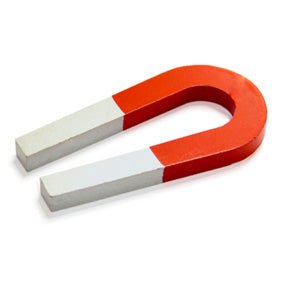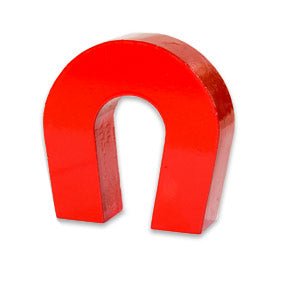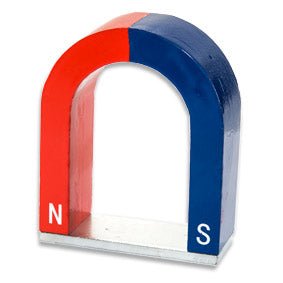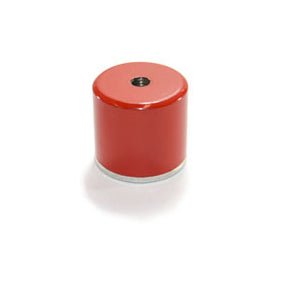Paint
Painted magnets generally refer to Alnico magnets with their traditional red paint. Ferrite magnets are also commonly painted to reveal the pole present at each end of the magnet. These types of magnets are popular in education settings as they allow students to easily understand the unique way magnets operate.
The term painted magnet could also apply to Neodymium magnets. These are nickel magnets which have been painted to give additional weather resistance or for aesthetic reasons.
Alnico magnets
Alnico magnets were first introduced in the 1930s and at the time they were the strongest form of magnet available. They were significantly more powerful than the commonly used ‘soft magnets’ which were steel based. They became the first mass produced permanent magnet.
Boasting an impressive curie temperature and a maximum operating temperature of over 500°C, Alnico magnets are certainly an appealing option for high temperature operations. For more information on the operating temperatures of different forms of magnet please take a look at our Knowledge Base articles.
The name Alnico is directly derived from the composite elements that form the magnet. These are Aluminium (Al), Nickel (Ni) and Cobalt (Co). Although it is worth noting they frequently contain other elements including Titanium, Copper and Iron.
Alnico cow magnets
“Cow magnets?” you ask. Yes, just as the name suggests these are indeed magnets for cows. Whilst grazing, cows can inadvertently eat nails, wire and other ferrous materials. This can lead to a bovine disease called Hardware Disease which can cause catastrophic damage in the cow’s digestive system.
Cow magnets help to prevent the disease by magnetically attracting stray ferrous items so they don’t travel further into the digestive system.
Alnico Horseshoe magnets
Horseshoe magnets get their name for their distinctive shape. The elongated U shape resembles the shoe of a horse. The amazing thing about this shape is that it is actually designed to focus the maximum magnetic field into the two ends.
Unlike other shapes of magnet, the two ends are present side by side due to the horseshoe shape. This is what achieves the enhanced magnetic power of the Horseshoe shape.
Universally recognised as the symbol for a magnet, this shape of magnet is the first magnet many of us will encounter in the classroom. School science laboratories across the world play host to demonstrations and experiments that unveil the magic of magnets.
Ferrite Magnets
Ferrite magnets are the other magnets that commonly fit into this painted magnet category. Horseshoe magnets and bar magnets are often painted in the quintessential blue and red to indicate the split in polarity. Popular in classrooms they are a more practical option than Neodymium magnets as they are far less brittle and are able to hold up to a moderate amount of handling.

Alnico Horseshoe Magnet - 75mm x 38mm x 9mm
Code: 49011
Not enough in stock. Please choose a lower quantity.
Minimum order quantity is 1

Alnico Cow Magnet - 75mm x 12mm | Rod Magnet
Code: 49025
Not enough in stock. Please choose a lower quantity.
Minimum order quantity is 1
Not enough in stock. Please choose a lower quantity.
Minimum order quantity is 1

Alnico Horseshoe Magnet - 51mm x 41mm x 16mm
Code: 49015
Not enough in stock. Please choose a lower quantity.
Minimum order quantity is 1

Alnico Block Magnet - 40mm x 12mm x 5mm
Code: 45020
Not enough in stock. Please choose a lower quantity.
Minimum order quantity is 1

Alnico Horseshoe Magnet - 100mm x 85mm x 33.5mm
Code: 49017
Not enough in stock. Please choose a lower quantity.
Minimum order quantity is 1
Not enough in stock. Please choose a lower quantity.
Minimum order quantity is 1

Alnico Pot Magnet - 17.5mm x 16mm
Code: 47110
Not enough in stock. Please choose a lower quantity.
Minimum order quantity is 1






